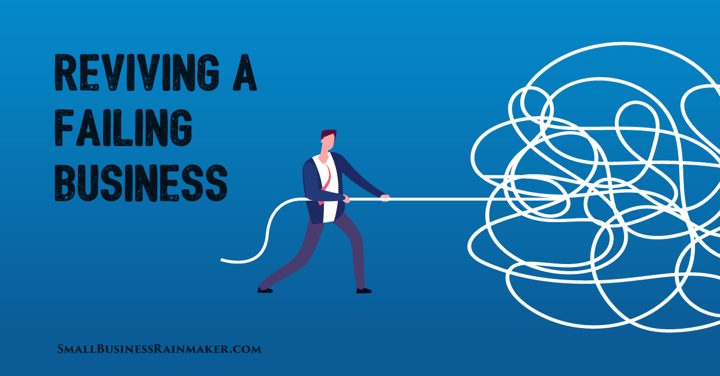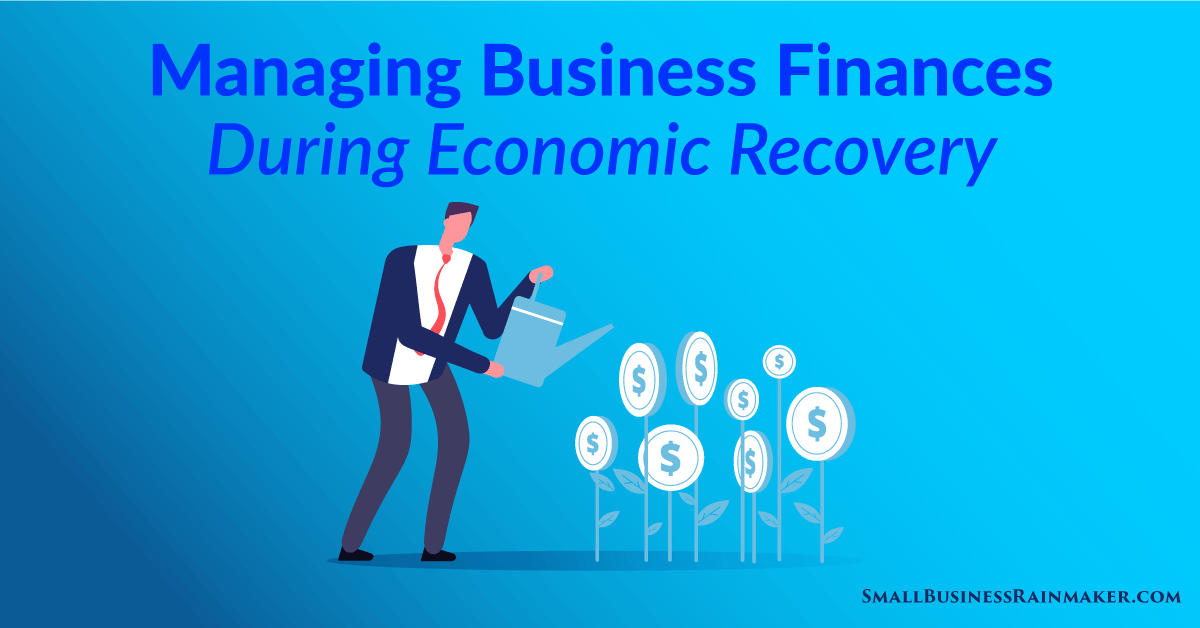
With the pandemic, these may be the worst of times for your small business. You may have been suffering before it hit, and now you're really in trouble.
Even in good times, ups and downs should be expected by any business owner.
Sometimes the business owner is at fault. They've neglected something or done something wrong.
Other times the reason is beyond their control. Outside forces – like corona or natural disasters – intervene and negatively impact business.
Either way, the fallout must be dealt with to get back on an even keel.
The following advice from various experts should help.
Obviously, some of the suggestions below only apply if your business is actually in operation now. But even if your business is temporarily shuttered because of the pandemic, you can still do some of these things, in preparation for re-opening.
What is a Small Business Turnaround Strategy?

Regarding the difference between a turnaround and “normal” business activity, Small Business Rainmaker Andre Palko says:
"All business is a constant course correction. We chart a course, start sailing and keep correcting to keep us going where we want to go. So at its heart, maybe a turnaround strategy is different only because we might have to take more extreme action. We’re encountering a gale versus a moderate wind shift."
How Small Business Has Been Faring during the Pandemic
The June 2020 MetLife and U.S. Chamber of Commerce Small Business Coronavirus Impact Poll indicates that the level of concern about the impact of COVID-19 subsided slightly over May's poll:
- 56% feel comfortable with their company’s cash flow situation, up from May’s low of 48% and similar to late March (59%).
- 50% expect next year’s revenues to increase, while 19% expect them to decrease.
- In May, 47% expected an increase in revenue and 25% expected a decrease in revenue.
On the negative side:
- 55% of small businesses believe it will take six months to a year before the U.S. business climate returns to normal, up from 50% in May and 46% in April.
Small businesses are taking action in various ways:
- More than 80% report that they are making, or planning to make, adaptations in response to the coronavirus.
- Nearly half (48%) have either started, or plan to start, more frequent cleaning/disinfecting of surfaces.
- 44% are asking, or plan to ask, employees to self-monitor for symptoms and stay home if they feel sick.
- Four in ten are also making, or planning to make, adaptations around employees wearing protective gear (40%) or requiring six feet of distance (39%) between employees and customers.
Timeless Lessons from a 9x Turnaround CEO
In light of the struggles facing small businesses during the pandemic, Main Street business advocate Ty Kiisel tapped turnaround CEO Dick Cross for 5 lessons that will help small businesses get through these difficult times:
1. Fear is the enemy.
Many small business owners are controlled by fear and suffer from the so-called "Imposter Syndrome." They fear having people discover that they're not as good at their job as they suspect people think they are.
His answer: "Admit that you don’t know everything. Surround yourself with smart people and learn from them."
2. The wrong metrics can do more harm than good.
Focus on the things that are really important and avoid tracking metrics of marginal importance just because you can. Pay attention to these metrics: customers, needs, positioning and competencies.
3. Treat people like volunteers, not employees.
Inspire them to give their best every day. Don't treat them like they're disposable. They may go elsewhere. Create a workplace where employees want to be.
4. Character matters.
These are the character traits of a successful business leader:
- Patience
- Kindness
- Generosity of spirit
- Courtesy
- Humility
- Unselfishness
- Good Humor
- Guilelessness
- Sincerity
5. Take time to think about what you're doing.
Set aside 60 minutes of uninterrupted time three times a week to do nothing but think about your business. He argues that this is the real job of the person at the top. The insight and inspiration you’ll gain makes this the most important thing you do every week.
How to Stabilize Your Small Business during the Pandemic

If you're one of the many small business owners devastated by Covid, you may be experiencing seriously depleted cash reserves, extensive layoffs of staff and personnel, and deep concerns about what lies ahead.
According to hard-hit small business owner Chad Otar:
"Because so many small businesses are lean and so many are bootstrapped, it doesn’t take much disruption to normal day-to-day operations to feel that squeeze. Small businesses certainly felt the impact of coronavirus first and continue to feel its impact disproportionately."
He offered 3 strategies to thrive during the pandemic:
1. As much as possible, normalize doing business just the way you always have. Your customers will feel a lot more comfortable and confident in businesses that aren’t making radical changes to their core business model for offerings.
2. Stabilize your cash flow situation as soon as possible. The Paycheck Protection Program is one option. And you'll see lots of quick ways to get cash and save money in the advice below.
3. Stay as flexible as possible going forward into this “new normal.” The economy is going to reopen, but the speed at which you're able to grow, build and expand will come down to your ability to remain fluid in how you serve your market and your customers.
During "Normal" Times, When and Why is it Necessary to Think about a Turnaround Strategy?
Many things separately or together can conspire to threaten a business's long term survival, driving the need for a business turnaround, including:
- Managerial inexperience
- Poor cash planning and control
- Improper timing
- Inadequate infrastructure
- Poor customer service quality
- Performance deterioration
- Ineffective marketing strategy
- Failing internal processes
- Poor policy implementation
According to research by Hassan Barau Singhry and Haruna Muhammad Khalid, Strategies for Reviving Non-Performing Small and Medium Enterprises,
"Managers tend to attribute performance decline and any resulting organizational crises to external factors beyond their control, such as competition. Empirical studies, however, show that very few business failures are the result of outside factors only. Instead, organizational failure is frequently linked to internal problems like failures to update products, invest in core competencies, and control cost.
The first stage of decline occurs when an organization’s adaptation to its domain or microniche (the product or market domain of the firm) deteriorates. The second stage occurs when the organization’s financial and human resources begin to diminish. Both stages of decline indicate that the organization has become less adapted to its microniche and is less successful at exchanging its outputs for new inputs.
Organizations enter the state of decline when they fail to anticipate, recognize, avoid, neutralize, or adapt to external or internal pressures."
Types of Turnaround Strategies and Tactics

Save Money and Reduce Spending
Perhaps one of the most pressing factors impacting the need for turnaround is money.
It's the rare business that doesn't experience revenue downturns at some point. No matter how the cash flow deficiency occurred (your fault or external factors) you'll probably need cash – and fast – to implement the needed change and increase revenues.
First, let's look at ways you can instantly SAVE money:
Cancel the following:
- Paid subscriptions for tools you're not using
- Memberships you're not participating in or getting value from
- Any services you pay for but don't take advantage of
Save by:
- Using rebates from cards and exchange loyalty bonuses you have due
- Getting discounts and privileges via memberships to relevant organizations
- Using comparison websites to see where you could save on things like business insurance, broadband packages, etc.
- Only paying when bills are due and not before.
- Using a business credit card that offers 30-day free credit. Only do this if you can pay in full within 30 days.
Reduce spending in several areas.
Here are 3 areas where you may be able to cut costs:
Payment terms:
- Pay early
- Pay later
- Discount on repeat purchases
Staffing and workload:
- Reduce full-time employees
- Hire interns for less
- Outsource
- Barter and exchange
- Become more efficient
Practical savings:
- Reduce cleaning and maintenance costs
- Cut utility bills
- Use open-source software
- Buy in bulk
Collect What People Owe You
Don't be shy about getting payments. You deserve to be paid in a timely fashion for the goods and services you provide.
Take action to get what you're owed:
- Adjust payment terms so customers pay earlier.
- Make it easy for people to pay you.
- Choose user-friendly invoicing software that looks professional, works smoothly and tracks your work securely.
- Don't let invoices go overdue. Use a collection agency, if need be.
Get Cash Fast!!!

To inject new cash into your business, instead of turning to a bank or benefactor for a loan, look to hidden, untapped opportunities already existing in your business. These are typically your current or past customers and hot leads, usually through existing customers, past customers and past prospects.
But before you rush into grabbing the cash, get clear on exactly:
- Why you need it
- What you'll use it for
- How much you need
- When you need it
- How you'll allocate or manage it
And, to avoid future cash flow problems and plan to cover gaps (and relieve anxiety), ask yourself if there are times of the year when you usually have cash problems.
Here are some strategies for quick cash injection:
1. Reach out to current and past customers
It's much easier to sell to people who already know you and your products and services.
- Encourage them to renew their contract.
- Let them know if it's time for a particular annual service.
- Offer them pre-paid packages.
- Let them know about your add-on services.
- Poll them for their customer experience.
- Offer them a complementary service you know they'll appreciate.
2. Run a time-sensitive offer
Entice buyers with a one-time sale. This works well with existing and past customers. You can also target a specific segment of your list.
Ideas for limited-time discount offers include:
- Calendar-related sales
- Impending price increase announcement
- Old inventory sell-off
- Gift cards and coupons
- Early bird pricing
3. Create a VIP offer for hot leads
VIP offers could be:
- Access to a meet-up online or a local breakfast meeting. Make an offer from the meeting.
- One-on-one access to you. Invite your leads to call or email you anytime during a specific period to discuss their business and how you can help.
- Create a VIP level customized package for one-on-one work and conduct an intensive VIP day live, or over Zoom or Skype.
Hot leads include:
- List subscribers who signed up for a lead magnet
- Your blog subscribers
- Regular Facebook page contributors
- Prospects who asked to be informed of new offers
4. Create new offers from existing ones
Pre-sell the new product, service, or course before it's created. This brings in your instant cash. Make sure you clearly state when they'll receive the product, and deliver it on time.
New offers you can roll out quickly include:
- Bundle existing products/services for a higher price
- One-on-one coaching by email over a specific period of time
- Create one or more ebooks from your most popular blog posts.
5. Higher pricing and new payment options
Small changes in your pricing can make a big difference. Compare your prices to the competition and make adjustments. If you're offering a valuable product or service, be sure you're charging enough.
Inform customers that prices will be going up, and tell them why and when. Then offer the opportunity to get the product or service again at the current price.
And offer payment plans. For instance, break up a $500 product into 3 equal monthly payments that total a little bit more than $500. Or take an advance deposit and structure payment at specific milestones.
Set up ways to get payment immediately using services like PayPal, Stripe, Square, etc.
6. Upsells, down-sells and cross-sells
Upsells
Upsells are an upgraded experience through higher-priced goods or services. Upsells at point-of-sale include:
- Prompt them to add additional items to the shopping cart before checkout.
- Offer a complementary service or product at a one-time special price.
- Recommend other goods or services that they can get quicker.
- Offer a ‘Deal of the Day’ for returning customers to motivate impulse buying.
Down-sells
Down-sells are a lower priced option of a product or service for those who want to spend less. For instance, offer a "taster" of your services that costs less than the full-price offering. Or break apart one product or service into multiple, lower-priced products or services.
Cross-sells
Cross-sells are complementary items offered as a part of the purchase.
Examples include:
- Batteries with electronic items
- Phone charger with the purchase of a phone
- A lead magnet template with start-up business development coaching
- Yoga mats with an online fitness program
Bundling several items into one sale, at a discount, is another cross-selling option.
Turn Around Your Product or Service Failure

If product or service failure is plaguing your business, Andre Palko suggests:
"Take stock when faced with a product failure. Don’t destroy that great idea ... just yet. It is indeed possible to re-launch a failed or sluggish product and in turn, revive a failing business. And if your business instincts are usually right, that’s even more reason to figure out what went wrong."
His 18 ideas to revitalize your failed or fading product or service
- Give your product a compelling, descriptive name.
- Give it a new name (if it had one first time around).
- Promote it using media you didn’t use the first time around.
- Change the product messaging.
- Change the product sales strategy.
- Tell a story about your product.
- Get someone else to promote your product.
- Find a new product distribution channel.
- Offer your product to beta test customers at a discount, or for free.
- Do a product launch.
- Speak at events attended by your ideal customers.
- Host an event that also features your product.
- Target a different market.
- Change your product pricing.
- Get strategic marketing advice from a business coach or marketing advisor.
- Examine the cultural background of your product target markets.
- Get creative, almost to the point of crazy.
- Try a different visual look for your packaging and promotion.
Harvard Business Review's Chief Editor and Change Management Expert Rosabeth Moss Kanter says "the key is to spot symptoms of decline before they accumulate, and then shift toward the actions that build positive momentum."
Her turnaround strategies that apply to any company
Be prepared for bad news; the situation is always worse than you think.
One symptom of decline is withholding information. Inconvenient facts are papered over. Decisions are made behind closed doors. Accusations and blame abound. So it is almost impossible to know the full extent of problems.

Identify the core assets that create value for customers and refurbish them.
Reallocate resources to restore assets. Improve the things that ARE working and think about eliminating things that aren't.
Find a meaningful unifying purpose.
Teams and companies with negative momentum are characterized by fragmentation — a drift into many activities that get tacked on and stay, becoming ends in themselves. It is too easy to lose sight of the larger purpose of being together.
Invest in teambuilding.
A cliché but still true. Convene strategy retreats. Find ways to heal wounds and promote stellar performance. Believe in and support team chemistry.
Give voice to people who haven’t been heard.
Every company is full of buried treasure. Find the ideas that might have been suppressed and bring them into the open or into action. Think small, as well as big.
6 Ways to Revitalize a Failing Business

Digital Marketing Strategist Nick Veneris laid out 6 steps to revive and turn around a failing business:
1. Reconsider the past, update, and change direction
Look through your metrics and your past approaches:
- What didn’t connect with your intended audience?
- Were they not engaging with your content?
- Were certain products you expected to sell well not selling at all?
- Were you simply targeting the wrong audience all along?
2. Do some market research
- What is it about your competitors that make them stand out?
- What is it that your audience is specifically looking for?
- Are you speaking to their interests or simply producing copywriting that speaks to your internal team?
3. Find your niche
Once, it might have been fruitful to be the business that had and did everything. Nowadays, it’s far more beneficial to be a business that specializes.
4. Seek help with affiliate marketing
Known as partnered affiliates, you can employ the contractual help of other business owners and social media influencers who will promote your product and business to their followers.
5. Undergo a brand redesign
Although time-consuming, this might just be your best option if your brand is truly on its last legs. By rebranding your company, you are changing its position in the marketplace, from the audience you are targeting to the way your company speaks.
6. Don’t be afraid to take some risks
You might feel that there is nothing you can do to turn around your business. But this crisis doesn’t have to mean the end of your business. Be ready to take some risks.
Go Back to the Basics of Building a Successful Small Business

Finally, check out this monster list of 77 business turnaround resources to help you improve all areas of small business management, including:
- Business process management
- Business operations management
- Small business and local SEO (Search Engine Optimization)
- Small business branding and personal branding
- Online reputation management
- Offline or traditional marketing
- Digital marketing
- Video and visual marketing
- Content marketing
- Social media marketing
- LinkedIn for small business
- Email marketing
- Customer service and customer experience
- Pricing
- Lead generation
- Sales growth
Conclusion
Turning a business around can be a daunting prospect for businesses of any size or age. Yet it doesn’t have to be complicated. Step back, analyze, stick to business basics and make sure you have cash on hand to do what needs to be done.















Leave a comment